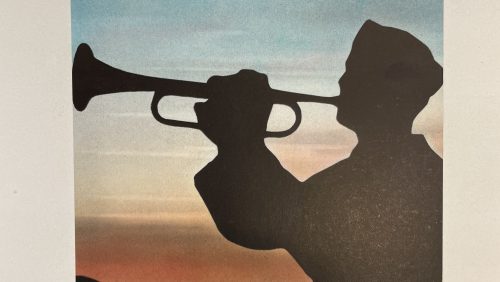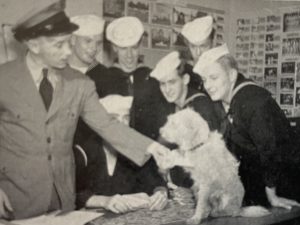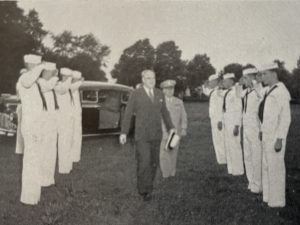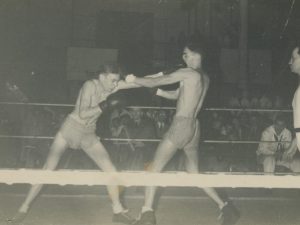The Homefront
Excerpted from The Ivy, 1947

Three years have passed on the hill since the class of 1944 presented the last Ivy. Perhaps in those intervening years the The Ivy was needed even more than in normal times, as the ever-shifting scenes of that period left no real record; but the several exigencies and the very speed of the war program left no room for The Ivy, nor were many of the delighting and powerful functions of Trinity College life continued.
Now, after a long interim, old Trin is beginning to recapture and revive. The Ivy appears at a time when temporarily-changed Trinity has just take her first solid steps toward being herself again.
What Happened in the War Years?
Editor’s Note: During World War II, Trinity College welcomed the V-12 Navy College Training Program, designed to supplement the force of commissioned officers. Numerous participants enrolled and attended classes and lectures .
In June, 1943, eighty freshmen and a few die-hard upperclassmen arrived to begin the first term of the accelerated program. They saw, with a rather weird sensation, that the Navy had moved in, four hundred strong. And so began a new era on the hill-the war years.
The many uniforms seemed strange to us at first but after a few months of being pushed off the walk by striding ranks of gobs, and of being awakened, come sunrise, by the hollow-booming “Hip, two, three, four” beneath our windows as the eager platoon marched to “chow”, we managed to accept fate quite comfortably.
Most of our classes contained a lot of V-12s. The Physics 1 lecture was a sea of blue with a couple of sport coats over in a corner. Of course, the sailors had some classes, such as Naval Organization, for themselves alone.
Summer of 1943
That summer of 1943 was pretty dull a far a college Life was concerned. The V-12s as a group, were unfamiliar with college in general and Trinity in particular, and few of them had time for extra-curricular activities. We freshmen, as freshmen always have done and always will do, were wandering around with our mouths open for months. The absence of upperclassmen and fraternities served to lengthen this phase.
With no warning at all the college was bereaved by the death of President [Remsen B.] Ogilby, in the latter part of the summer. His death was a great shock to all in the college, and it almost disrupted things completely. Dean [Arthur H.] Hughes and the rest of the faculty stepped in immediately to close the gap. Prexy Ogilby would have wanted them to carry on the curriculum as usual, and carried on it was.
We suffered another loss which we could ill afford lacer on that summer-Dr. Wadlund. Liked and respected Jarvis Professor of Physics. Dr. [Henry Augustus] Perkins returned to the college to take his place.
Summer ’43, was a real turning-point. The Navy occupied practically all of the rooms on campus, and the college was using as dormitories those fraternity house whose chapters had mutually agreed to remain inactive for the duration of the emergency.
Change were made in all departments. In the gym, wrestling and judo were the orders of the day. The Navy had P. T. five days a week and we had it three, but when we went we did what they did; under the tutelage of Mr. James we duly emerged as artists in mayhem, Navy style.
In a surprisingly short time, the first term of the accelerated program was almost over. Exams were in the very near offing; both groups, Trinity men and V-12s, were new to the heart-rending things, and no one knew what to expect. Finally, however, exam week was behind us, and after a long and leisurely vacation of an hour and a quarter, we plunged into the maelstrom once again.
Fall of 1943
In the fall (and it was about time) we actually had a basketball team, that fall and winter-the a y managed to take sufficient time off from drilling, etc., to play twelve games and distinguish themselves in the process. With Ray Oosting coaching, we won one and lost one with Yale, Coast Guard and Williams, beat M. I. T., Worcester Tech and Middlebury, and lot to Rensselaer. But best of all, we beat Wesleyan twice. Hayes of the V-12 captained the team.
The sailors put on a play of sorts, entitled “Midsummer Nightmare”. Among the feature were a completely disconnected plot and gibberish instead of dialogue. Two things saved the show-one was the very dream-like appearance of the King Knighters, in the flesh, on our little stage-they had been performing for the multitudes downtown at the State, and some genius on campus had gone and persuaded them to come up and give Trinity a glimpse of the outside world.
The other illustrious phenomenon of the show was the entrance of a salty tar who, upon turning ’round, was revealed to be Professor [Henry Augustus] Perkins. The Professor’s riotous lesson in “Stretching the Paycheck” was much appreciated, and he showed us how a clarinet ought to be played, too.
The Navy teamed up with the Trinity men a little earlier that fall to stage that mad product of Ken Yudowitch’s pen, “The Stratagoon Ray”. The “Ray” was an Allied secret weapon, and the play depicted the attempts of a Nazi spy ring to steal it. The acts of espionage necessitated calling in the President of the United States and many learned scholars from all over the country, some of whom bore an amazing resemblance to members of the Trinity faculty. According to Ralph Monaghan, the show was a howling success. After both plays, several individuals appeared on the campus masked, and remained so for some week . We wondered what the connection was, but never found out.
Spring of 1944
In the spring of 1944, the track men shone. We had four meets, with Worcester Tech, Middlebury, Union, and Wesleyan, and we won all of them by great margins. (Example: Wesleyan 37½ points, Trin 88½.) Mr. Oosting coached, and Halsted of the V-12 captained. Four new Trinity records were made in the one sea on: Pete Torrey put the old shot 42 ft. 5 ½ in., Halsted buzzed the high hurdles in 15 .9 sec., Campbell tore off a mile in 4 min. 32 sec., and Carleton ran the hundred in 10.0 5 sec. That was some team!
Spring came very early in ’44. Too early for the students’ good, some narrow-minded people were heard to say. They probably were right-but then, the advent of the balmy days is pretty much the same every year. The old carefree spirit starts taking hold – it’s light outdoors after supper until all hour , and it would be soo nice to forget the Physics for just a few minutes and take a run down to the drugstore or go for a little ride out to Northampton or some such nearby place.
Winter of 1944 saw the production of another all-Navy how, “Strictly from Hunger”, a take-off on “Hellzapoppin”. As can be seen in the picture they really went all-out to be zany. Ladies with weak stomachs or delicate senses of humor were advised not to attend; but as not many of us fell in that category we managed to get a big kick out of the many triple-entendres that were shot at us.
Sigma Nu was the only fraternity active at this time, and in the winter term of 1944 they were really rolling along, doing a lot of pledging and having many rather violent parties. There were myriads of men living in the Sigma Nu house then, and the escapades of such brothers as Epp , Hollings and Lattazori were legion.
In the early spring of 1944 the original word and Key Society was established by six men three fraternity men and three non-fraternity. Their object in starting the Society was to provide and maintain the spirit of a secret brotherhood for suitable men while only one fraternity was active, and to give opportunity for a greater social life, as the college even after the Navy had been there a year, had regained almost nothing of its old atmosphere. word and Key held forth with parties in the Delta Phi and Alpha Chi Rho house , and at the end of the term included about twenty-fie men.
All during the time that the Navy was here, we civilians ate in Ogilby Hall, the dining room in the Upperclass Dorm. With Mr. Cummings managing, and first John Rich and then Isaac Fish as chef, this substitute Commons put out a steady flow of food and a fluctuating amount of service for three years.
Later on in the spring of 1944 the Navy began to get quite formal and shipshape and held all sorts of ceremonial functions-war Bond drives, gubernatorial reviews, etc., most of which were rather impressive. Especially noteworthy in the minds of the V-12s were those events which were attended by Waves. During one Bond rally huge numbers of them came up and tore around all over the campus in jeeps. Big displays were set up on the lawn over by the chapel, the Navy band played, and a very martial time was had by all. We wondered whether the 100 percent contribution of the Unit to the drive was caused in any way by the presence of the female sailors at the subscription desks, but were assured that this was in no way the case.
Somewhere the sailors picked up a mascot, a little white dog of dubious ancestry, which they named “4-0” and promptly taught to bark and snap at all civilians. Revenge was obtained when “4-0” picked a :fight with Professor Towle’s Scotty and was roundly thrashed. Plans were afoot among the Trinity men for dyeing “4-0” green with pink stripes, but this dastardly deed was never accomplished.
There was much excitement when Governor Baldwin came up and reviewed the V-12 unit and spoke to the Political Science Club. Stan Kligfeld took charge personally and showed the Governor a very fine time.
The Navy used to drill a great many times a week down on the athletic field and on most of the rest of the campus, and as spring and summer progressed they were able to put on a darned fine showing, if we do say so. Their efforts were so earnest a far as marching was concerned that a large part of the campus had to be reseeded. What the heck they meant well.
Winter of 1945
In the winter of 1945 we had another good basketball team. “Red” Faber captained, and he was one of the most skillful and best-known players in New England, averaging 15 to 17 points a game. With Mr. Oosting coaching, as usual, we won one and lost one with Wesleyan and the Coast Guard Academy, lost to Yale twice, and lost to the New London Submarine Base, Rensselaer, once apiece; beat M.I.T. twice, and beat Williams, Middlebury, Union and Holy Cross once each. All of the games were very close, the final scores usually being not more than five or six points apart. The Holy Cross game was the best game of the season-as the end of the game approached they were two points ahead, but just before the gun Trin tied it up with two foul shots, and went into overtime to score one point and win with 55 points to Holy Cross’ 54.
Late in the spring of 1945, two Admirals came to the college at different times to review the V-12 unit. Admiral Hart held his review from the Old State House downtown in Hartford, and the sailors held their parade along Main Street, much to the awe of the populace; later, in June, Admiral Jacobs arrived to hold a graduation review and to be presented with an honorary degree. Both affair were carried off with much pomp and circumstance.
From term to term during the accelerated program the Navy unit was gradually reduced in size. They began in 1943 with something over four hundred men, and by the spring of 1945 had been cut down to about two hundred. We heard somewhere chat Trinity was supposed to have had one of the highest percentages of Navy trainees failing to make the grade anywhere. This may ha e been due to the fact that we made no special allowances, but kept right on with our normal requirements in the individual courses-who knows?
Summer of 1945
The summer term of 1945 was the last full term that the V-12 remained at Trinity. The size of the unit was at its lowest, and a comparatively large number of civilian freshmen entered, some returning from the armed services, but most of them just out of high and prep schools and beginning their college careers. The summer went by rapidly-the campus was pervaded by the feeling that soon, in the fall, great changes would occur. Then suddenly fall exams were upon us, and the last term of Trinity’s accelerated program was over.
September, the beginning of the fall term of 1945, saw the Navy still with us; on October 15th, however, the last men of the unit left. All fall the college ·was very busy reconverting the dormitory room for ordinary student use, and trying to accommodate the rush of veterans, both former Trinity men and those just starting at Trinity, which was by now inundating the Admissions Office.
President-to-be George K. Funston appeared on campus and turned on full steam in trying to get you back to normal as quickly as possible. With enrollments starting to climb back toward pre-war magnitude, little by little Trinity began to change to the happy peace-time college chat only then, in the spring of I 946, were we really beginning to know once more.
Wherever God’s great mandate runs
She counts the tally of her sons,
Embattled, armed in panoply,
Beneath the name of Trinity …
To those Trinity men who died in the Second World War, the 1947 Ivy is respectfully
dedicated.
PASQUALE R. ARACE
FREDERICK L. BARRETT
GEORGE S. BASSETT
WILLIAM H. BEATTY J
ACQUES E. BLOCH
JOHN H. BURNS
GEORGE H. CLARKE
HORACE G. CLEVELAND Ill
GEORGE F. COBB
MALCOLM CROCKER
LESLIE L. CURTIS
ROBERT J. DERICK
RICHARD W. DEXTER
PHILIP C. DRYDEN
HENRY P. EICHACKER
RICHARD M. FARNSWORTH
ROBERT N. FLANDERS
THOMAS W. FLANIGAN
ROCCO A. FRANCHI
CHARLES E. FRAZEE
HERBERT R. GILMAN
REX E. GREENE
LOU IS R. GUZZO
MUMFORD M. HEARD
HENRY G. HONEYSETT
ELMER G. HUBER
ROBERT R. HUNTER
WILLIAM W. JOHNSON
OGDEN JONES
FRANK C. JONES, JR.
ELDRED A. KERRY, JR.
ROGER C. KILEY
FRANCIS C. KOWALCZYK
LAWRENCE L. LATTIZORI
CHARLES H. LEFEVRE
ROBERT S. MANION
NEWTON H. MASON
DANIEL B. McCOOK
LESLIE W. McWILLIAMS
JOHN F. MELACK
SIDNEY A. MILLS
CHARLES H. MORTIMER
RODERICK J. MURRAY
JOHN B. NASUTA
GEORGE C. NELSON
EDWARD A. O’MALLEY
BORIS W. PACELIA
GEORGE B. PATTERSON
JOHN PEARSON
HOWARD C. PETTERSON
MARK RAINSFORD
JOHN J. RAU
JUDSON S. RAMAKER
JOHN F. REYNOLDS
WALTON K. RODGERS
JOHN S. SAUNDERS
JOHN E. SLOWIK
CHARLES E. SPRINGER
GORDON STERLING
GILBERT S. TABOR, JR.
EDWIN P. TAYLOR Ill
WALTER STARK TAYLOR
CHARLES W. TOURISON
JOHN H. WAMSLEY
WILLIAM H. WARNER
JOHN W. WEISSHEIMER
JOHN WILLIAMS, JR
CLEVELAND C. WOODWARD
What are the drifting years to her
Whom nought can hasten or defer?
She smiles at time. Her pilgrimage
Proceeds from changing age to age…


